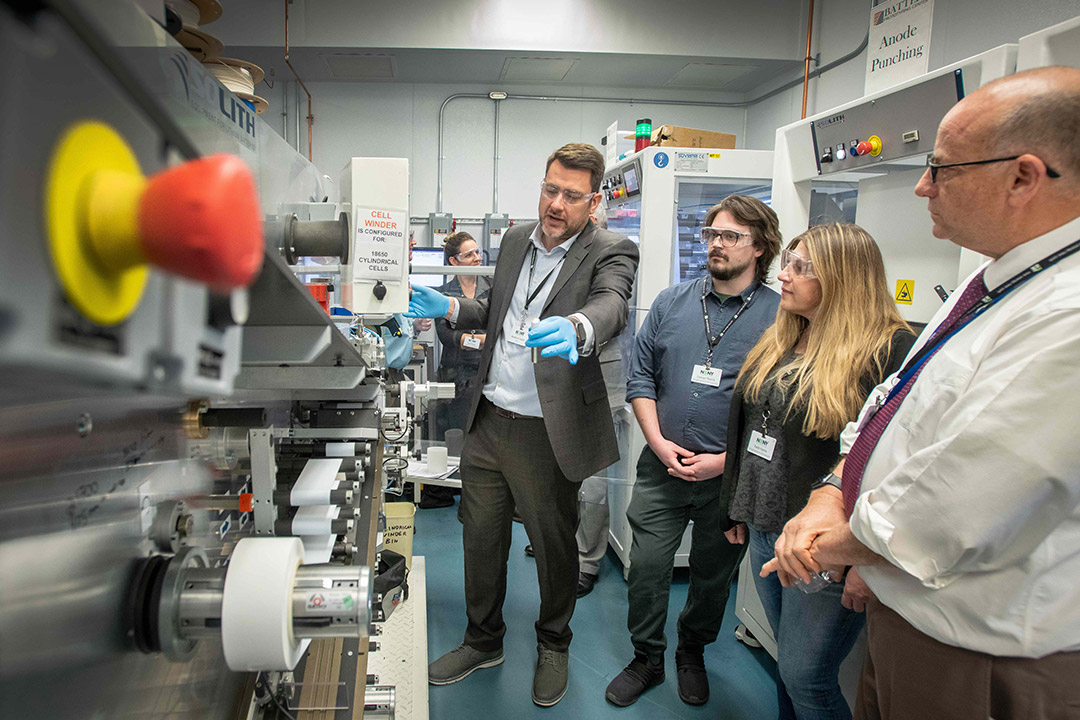RIT Battery Prototyping Center awarded more than $2 million
Center experiences growth in demands for services to support research and business start-ups
Carlos Ortiz/RIT
Members of the New Energy New York (NENY) coalition toured RIT’s Battery Prototyping Center on Nov. 16 with Matthew Ganter, left, director of the center. NENY members included Cooper Pierce, NENY instructional designer; Faith Vavra, Government Relations, SUNY Binghamton; and Robert Murphy, director, Office of Employment and Training, Broome County. The NENY collation is building a U.S. battery manufacturing and workforce development hub in New York.
The Battery Prototyping Center at Rochester Institute of Technology was awarded nearly $2.2 million through the Empire State Development Grants program to expand its facility.
Upgrades and expansion of the center will nearly double its current space, add new equipment, and increase training capacity in the areas of lithium-ion battery research, manufacturing, and development.
The Empire State Development Grants program supports capital-based economic development projects intended to create new or retain current jobs in the state, specifically in the areas of bio-health, clean energy, and manufacturing.
“The outlook for the battery industry is positive; that’s why there is so much investment in this area. Our industry could grow by more than 10 times its current rate,” said Matthew Ganter, director of the Battery Prototyping Center. “We’ve seen costs for current batteries drop more than 85 percent since 2010 while energy density has doubled. There’s still a lot of development to be done, especially in the areas of sustainable materials, reducing the impact of manufacturing processes, and recycling.”
Established in 2014, RIT’s Battery Prototyping Center specializes in emerging energy storage technologies as well as manufacturing and assembly of lithium-ion pouch and cylindrical cells. It takes a lot of work to improve battery density; there are multiple components and chemical reactions inherent in the development of any battery type, including the lithium-ion cells produced in the center.
The Battery Center is one of several areas receiving state and national investments over the past several years toward strategic economic development programming. Funding will be used for equipment and support for workshops and training programs. RIT’s center will continue its annual seminar programming—two-day overviews and demonstrations of services and processes. It will also launch a new 10-week online course with onsite lab options in spring aimed at technicians and engineers.
More space and expansion of services is also necessary as the Battery Prototyping Center became part of the New Energy New York (NENY) coalition in 2022. Based at SUNY Binghamton and led by Chemistry Nobelist M. Stanley Whittingham, NENY brings together expertise from industry and academic partners to establish a major battery innovation, manufacturing and workforce development hub in the state.
The hub will coordinate several key areas: improving and scaling up battery technology and manufacturing capacity, supply chain development, workforce development, elevating climate and justice initiatives, and encouraging innovation and entrepreneurship.
“Battery evolution has come from new chemistries and manufacturing techniques. Transportation will be the largest driver of growth in battery technologies in the next 10 to 20 years,” said Ganter. “There is still room to grow even as we get closer to mass adoption of electric vehicles. Training and workforce development of battery scientists, technicians, and engineers is essential to meet the industry demands in the U.S.”










